 |
||
|
||
| ||
160 GB of Perpendicular Magnetic Recording in the 2.5-inch Form Factor from Western Digital
The previous article was devoted to EIDE and Serial ATA WD Scorpio ML60 120 GB drives — top second-gen mobile hard drives from WD. But WD has currently launched 2.5-inch hard drives of the third generation — Scorpio ML80, 160 GB max, based on 80 GB platters with perpendicular magnetic recording. Since the beginning of 2006, several companies are manufacturing similar hard drives that use perpendicular magnetic recording (PMR) instead of the traditional longitudinal recording. Seagate with its Momentus 5400.3 is the leader here (in terms of release dates).
However, we shouldn't forget that Fujitsu launched the first mobile 160 GB MHV2160BT model with traditional longitudinal recording and three platters instead of two. As we reviewed previous PMR models from Seagate, Hitachi and Samsung (see the links above), each time we made a conclusion that delays in launching the first PMR drives (Hitachi relative to Seagate, Samsung relative to the first two) did only good to the products, because each time the new product was a tad better than its competitors, including performance in typical notebook tasks. Delayed WD Scorpio ML80 drives also have a chance to blend in with this tendency, because they use the streamlined PMR technology and rich traditions of successful hard drives Scorpio ML40 and Scorpio ML60. Let's examine the top model - Scorpio ML80 WD1600BEVS.
WD Scorpio of the third generation — ML80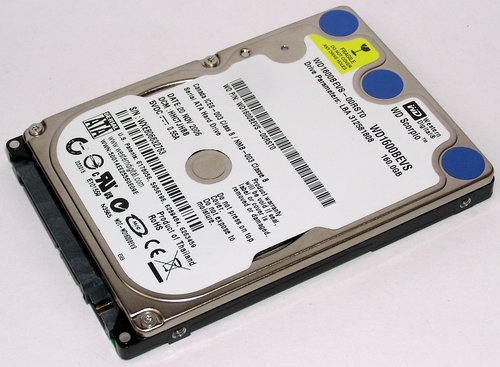 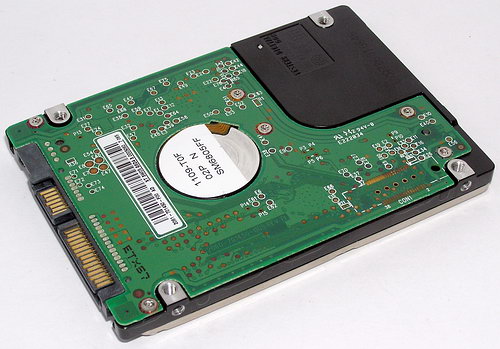 WD Scorpio WD1600BEVS.
Table 1 compares main specifications of WD Scorpio ML80 drives with older models. Table 1. Key Specifications of WD Scorpio ML80 Drives with Serial ATA and UltraATA/100 Interfaces.
3G WD Scorpio drives (ML80) are notable for using platters with PMR, 80 GB maximum (older Scorpio drives used 60 GB and 40 GB platters). However, cheaper ML80 models allow formatting these platters to lower capacity, although they always use the PMR technology. Maximum density and transfer rates are guaranteed only in top 160-GB models of this generation (and probably in single-platter 80 GB models). You can find out the generation (family) of a Scorpio drive by the two middle letters in its index that follow its designation: WDxxxxxxxx—xxYYxx:
Compared to ML60, the ML80 family is supplemented with 160 GB models. Their transfer rate has grown by 20% (600 versus 500 Mbits/s). The power consumption has grown a little (higher head current and changed VCM signal form). Besides, the range of operating temperatures has been expanded — new WD drives operate from 0°C. In other respects, everything is just like in ML60. When this article was being written, the Scorpio ML80 series offered only SATA models, and WD drives with EIDE interface belonged to old Scorpio ML60. But WD plans on launching ML80 EIDE models by Q3 2007 If we compare Scorpio data with specifications of competing products of the same generation (that is 80 GB platters with PMR), WD drives are no worse: possessing a higher buffer to disk transfer rate (600 Mbits/s versus 530-540 Mbits/s in competing products), they offer a little worse operating shock resistance, a wider range of operating temperatures than in Hitachi and Samsung drives, and a tad higher power consumption (according to specifications). The exterior of WD Scorpio ML80 drives has suffered some changes compared to ML60: 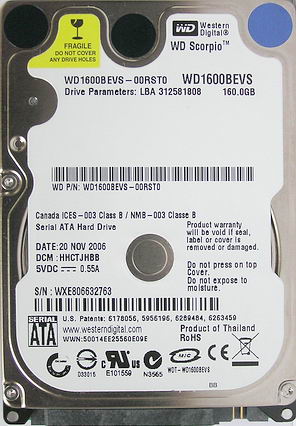
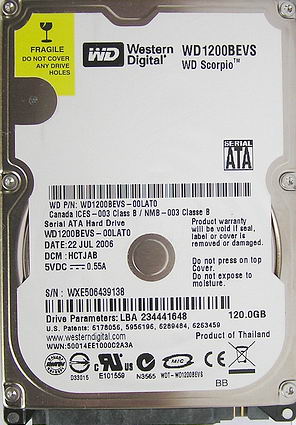 WD Scorpio WD1600BEVS (ML80) and WD1200BEVS (ML60).
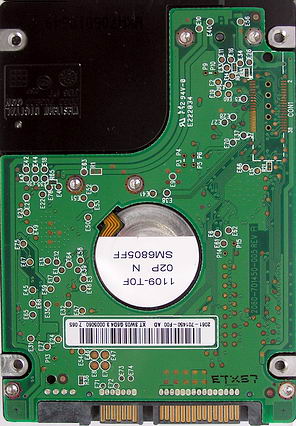
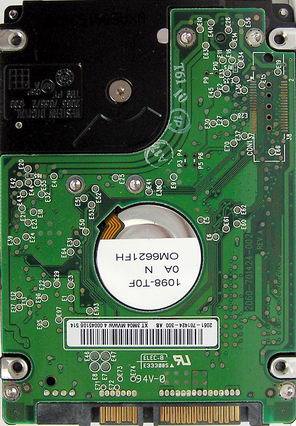 WD Scorpio WD1600BEVS (left) and WD1200BEVS (right), a view from the controller.
PCB of the controller has been evidently modified as well. 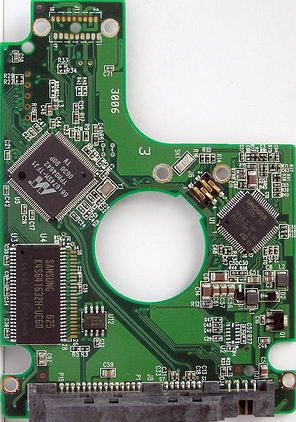
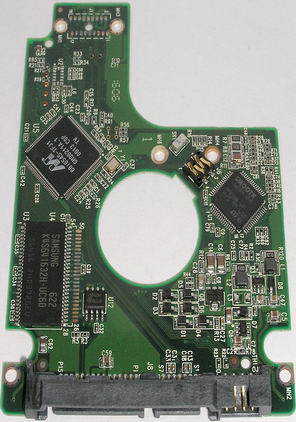 Controller boards of WD Scorpio WD1600BEVS (ML80, left) and WD1200BEVS (ML60, right).
For example, the block of voltage regulators has been simplified, a new signal processor Marvell 88i6745M is used instead of 88i6545. 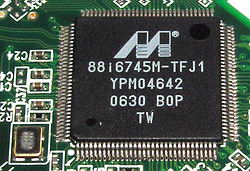
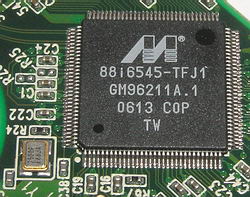 Microcontrollers of WD Scorpio WD1600BEVS (top) and WD1200BEVS (bottom).
Changes have been also made to the servo controller — the new ML80 series uses Smooth L7206, while ML60 was equipped with Smooth L6284.  A fragment of the controller board in WD Scorpio WD1600BEVS.
That's the back view of the "hermetic unit" of the WD1600BEVS drive (controller board is removed): 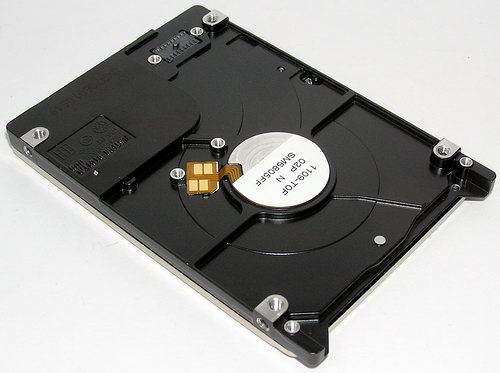 There are some changes here as well. Serial ATA connector on the WD1600BEVS board is similar to that in ML60, with a reinforced casing to avoid accidental contact damage. 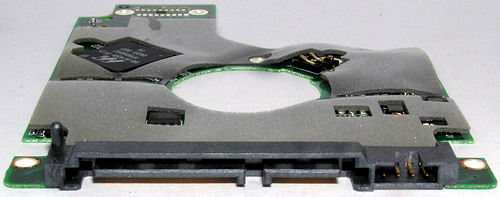 This screenshot provides a pretty good idea of supported functions: 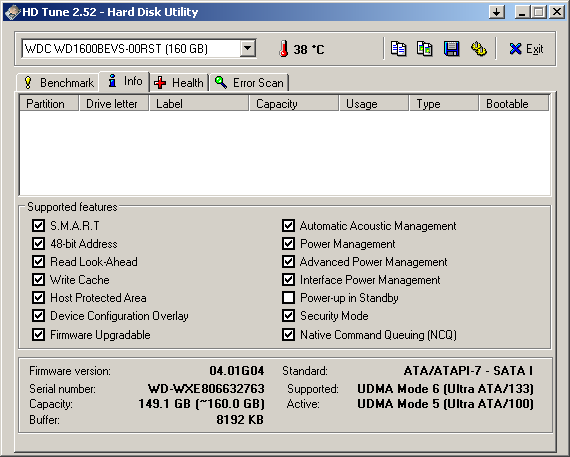 These drives support seek acoustic management. AAM is disabled by default, although the drive remains quiet, almost inaudible against the background noise of rotating platters. You can use utilities to change the AAM register and set the quiet seek mode (HDD Life screenshot): 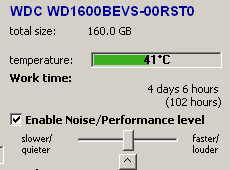 Then we are going to benchmark performance and power consumption of the WD1600BEVS drive in both seek modes — with AAM disabled (default) and AAM=128dec (quiet seek).
Test participantsIn this review we are going to test Scorpio ML80 WD1600BEVS 160 GB, Serial ATA, manufactured in November 2006. It will be compared to previously reviewed (see the links) modern 2.5" hard drives from various manufacturers — both Serial ATA and UltraATA models:
The most interesting comparison is WD1600BEVS versus its direct competitors — mobile 5K models (160 GB) from Hitachi, Samsung and Seagate that use PMR (they are printed in bold in this list). The same concerns its direct predecessors — WD Scorpio ML60 120 GB. All hard drives, except for Toshiba, are equipped with 8 MB buffers. You can compare performance results of our contenders with older hard drives on your own - just use the data from our previous reviews, as they used the same test procedure.
Performance Test ProcedureWe haven't changed the procedure yet - we used the following testbed configuration to test 2.5" drives:
The mobile drives are mounted firmly on the metal racks of a testbed chassis and connected via an adapter to the UltraATA/100 controller or directly to the Serial ATA controller on the ICH5 bridge. Besides, the WD1600BEVS model was also tested with the SiI3124 controller in order to evaluate NCQ effect (NCQ benefits in desktop drives from WD were quite ambiguous). The main hard disk was installed as master on the first channel of the chipset controller, and a hard disk to be tested was installed as master on the second channel of the same controller. The tests were carried out under MS Windows XP Professional SP1. The hard disks were tested not partitioned (in Intel Iometer, H2Benchw and AIDA32 tests) as well as partitioned and formatted by regular operating system tools depending on a test type: one NTFS partition of maximum size for testing the average access time and plotting the read speed graph in WinBench 99 and two NTFS or FAT32 partitions of the same size for other tests (WinBench Disk WinMark 99, copying files with various patterns, ATTO Disk Benchmark test, multithreaded read/write Nbench 2.4 test and the hard disk speed test in Adobe Photoshop). Each NTFS partition occupied half of the entire disk capacity (that is the second partition started exactly from the second half of the disk). FAT32 partitions were 32768MB, the first one starting at the outer edge of the media (on the "fastest" tracks), and the second — exactly from the second half of the media volume. NTFS and FAT32 cluster sizes were selected by default — 4 and 16 kB correspondingly. We used AIDA32, H2benchw, and WinBench 99 tests to find out physical characteristics of drives (average access time, interface transfer rates, and linear disk transfer rates). To estimate the overall performance we use multiple patterns from Intel Iometer, a good test C'T H2Benchw, Adobe Photoshop swapping performance, multithreaded read/write, and the generally recognized WinBench 99.
Baseline Test ResultsFirst of all, we are going to publish linear reading graphs (click on them to see full-size diagrams).
Let's compare the graphs:
By the way, the graphs of linear reading and writing rates, plotted in HD Tach 3.0.1.0 for WD1600BEVS, are practically identical (see the screenshot: reading - red, writing - maroon). 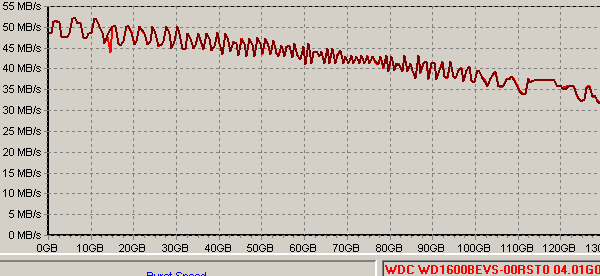 In the beginning of the disk, the transfer rate sometimes even exceeds 50 Mbytes/s. What concerns Serial ATA interface rates, the ML80 drive demonstrates a tad worse results than ML60 with the same controller. It may have to do with the new controller. However, the interface transfer rate is much higher than the linear read rates of mobile hard drives so far, so it cannot be a bottleneck. Average disk access time of the new WD Scorpio model is even a tad better than in Scorpio ML60, that is the WD1600BEVS is outperformed here only by 5K models from Seagate and Hitachi. Another interesting fact - results of our model under review in quiet seek (allegedly slower) mode are no worse. That is there are practically no seek slowdowns in the quiet mode! Efficiency of caching data for writing can be evaluated with the random access test under Windows: Unfortunately, results of the WD1600BEVS are a tad worse than in its immediate predecessor (WD1200BEVS). But they are evidently better in quiet seek mode. Does the firmware really switch to more efficient caching of random write data, when quiet seek mode is activated? ;) We also detected an interesting peculiarity of average disk access time for writing in the WD1600BEVS - it changes as the drive warms up. A 10-minute test in Everest shows that this parameter may grow a little in time:  We have never seen this phenomenon in other drives. An explanation to this probably lies in disk engine physics and how accurately a head is positioned over a track as it warms up. Thus, our model under review demonstrates quite decent results in basic tests (the best linear access time, good random access time for reading, and excellent data caching for random writing). Considering algorithms of ML60 and ML40, well optimized for personal applications, we can expect high results in applications from ML80.
Performance in applicationsIn multi-threaded read/write performance tests with 100 MB files, WD Scorpio ML80 takes the second place after Samsung M80 in writing (results of the ML60 are evidently improved) and a mediocre place in reading. Interestingly, our model under review reads faster in quiet seek mode than in usual mode (do you remember about the "algorithms"? ;)), but NCQ cardinally saves the day in WD1600BEVS — when this model demonstrates fantastic performance! On the contrary, Samsung M80 loses some of its multi-threaded read performance with NCQ. Detailed results of multi-threaded read/write patterns are published here and here. Disk WinMark 99 tests favour our models under review. Firstly, the Business test is disposed toward good caching data for writing, so the new WD drives are the best among mobile 160 GB models. The model under review is not defeated in High-End test either, only the new Hitachi Travelstar 7K100 is better. Hard drive performance in a typical personal computer mode is also estimated with two other popular complex track tests — Futuremark PCmark 04 and C'T H2benchW. The WD1600BEVS again demonstrates excellent speed in the first test (especially in quiet seek mode). It performs almost on the same level with Samsung M80. Unfortunately, NCQ is of no help here. Another track test, C'T H2benchW, confirms that these are not just coincidences, but a regularity that has to do with good optimization of the ML80 firmware on the new controller. However, the WD1600BEVS is slightly outperformed by 160 GB models from Hitachi and Samsung here. In return, the top Scorpio ML80 model demonstrates excellent Adobe Photoshop swapping performance. It's outperformed only by the splendid Hitachi 7K100, the other models left far behind.
Intel Iometer testsAnd now let's see how our models under review fare in various IOmeter patterns, although they are not typical patterns for these drives. However, databases on notebooks are not considered exotic anymore, so these patterns have a practical aspect as well. Let's start with mean results of traditional File Server, Web Server and Database patterns. It would have been naive to expect good results from this model here. Nevertheless, the WD1600BEVS demonstrates excellent results. It surely outperforms all 5K models. And when it uses NCQ, it can compete even with mobile 7K drives! (I'll remind you that NCQ did not yield a positive effect in Samsung HM160JI here. On the contrary, the effect was rather negative). A similar situation is demonstrated in the Workstation pattern, and the quiet seek mode does not deteriorate performance of the WD drive. Now what concerns more "personal" tasks like reading, writing, and copying large and small files, where performance is evaluated by our own random access patterns across the entire disk. We can note that WD Scorpio ML80 drives perform worse here. They are outperformed not only by most modern 5K models, but also by their predecessor - WD1200BEVS. You can look up performance results in each of these tests (reading, writing, and copying large and small files) at the following three links to the diagrams.
In particular, we can note a performance drop (relative to WD1200BEVS) for reading large files, a small performance drop for writing small files, as well as for copying large and small files. WD Scorpio drives are significantly outperformed by all their competitors in copying large files. The WD1600BEVS does not perform well in defragmentation pattern either, its performance drops significantly on NTFS. And following the ill-famed traditions of the Scorpio ML60 in streaming read/write patterns (simultaneous) for large and small blocks (that imitate the timeshifting function in a digital VCR or video editing load on a hard drive), our model under review demonstrates very low performance with small blocks. But WD Scorpio ML80 performs rather well with larger 64 kB blocks (more typical).
Power Consumption and Heat DissipationFollowing the streamlined test procedure (see, for example, here and here), we also measured the typical current drain of these drives in various operation modes: idle (just spinning), read, write, active seek, ATA-interface operation, power up, etc. These very parameters in complex reflect well the situation with HDD temperature (current multiplied by voltage (5V) gives the power dissipated by a hard drive, it wouldn't have been very informative to measure HDD temperature inside a notebook) as well as with power saving of a hard drive as part of a notebook with a known "heat package". Average power consumption readings in the main modes are published in Table 2 (an ammeter with the internal resistance of 0.1 Ohm was connected to the +5V line). Some modes should be commented on:
All the modes, except for Start, were measured during the corresponding stages of AIDA32 Disk Benchmark. The table contains only maximal results for the read and write operations (at the beginning of the disk). Table 2. Current drain (mA) of hard drives on the +5V line in various modes.
The average current drain of the WD1600BEVS in quiet seek mode is practically identical to that in the regular seek mode. The same concerns other operating modes. At the same time, the new product is less economical than its predecessor (WD1200BEVS) with the same interface (the specifications are correct): while its idle current drain is practically the same, and it's even reduced by 30 mA when packets are sent through the interface, the average current drain of the top PMR ML80 model at startup, reading and writing is higher by 30-40 mA than in the top ML60 model with traditional longitudinal recording. Average power consumption of mobile drives for typical and intensive disk usage is calculated by the following usage patterns: 1. Model of the average hard disk power consumption for typical unhurried operations of a user (for example, office work or editing graphics) can be described by the following formula: P typ =(Idle*90%+ Write*2.5%+ Read*7.5%)/100%, where lettered modes denote the power consumption of a drive in the corresponding modes; digits (multipliers for these power values) denote percentage of the HDD mode duration (we take maximum power consumption values for reading and writing, which correspond to the beginning zones of a disk; Seek mode is actually metered here through reading and writing). This model is based on the assumption that read/write HDD operations make up 10% of the total time for the typical notebook usage. 2. The same concerns the average power consumption during intensive hard disk operations (for example, defragmenting disks, scanning the surface, copying files, etc.) can be defined by the following formula: P max =(Write + Seek + Read*3)/5, where the current is given in amperes. The following diagram was plotted by the calculated power consumption values. The average power consumption of mobile drives for typical and intensive disk usage.
As we expected, the WD1600BESV failed to break any power saving records: 1.12 Watt for typical load and 3.17 Watt for active operations — we are not used to seeing such results in modern models any more. They are worse than in all other 160 GB models from competitors. They are even worse than in the older WD1200BEVS model. It's hard to tell what drove WD engineers to raise power consumption of Scorpio models from generation to generation (while their competitors reduced it). Perhaps, upgrading to perpendicular magnetic recording and traditionally high requirements to reliability of WD products made the engineers do it. It's a pity — WD Scorpio ML40 drives of the first generation were the most economical 5K drives in the market. However, these parameters are not fatal in ML80 drives either. The WD1600BEVS demonstrates acceptable power consumption for a mobile 5K drive in various modes.
ConclusionsWestern Digital was not in a hurry to launch the third generation of its Scorpio hard drives for notebooks. This company let the other manufacturers be the first to master 160 GB and PMR. Having waited a little and borrowed the streamlined PMR technology, WD launched Scorpio ML80 with the top SATA model WD1600BEVS a tad later than its competitors. But in return, the company managed to raise transfer rates of its 2.5" 160 GB models to new heights - 50 Mbytes/s, as well as to improve average seek time compared to old Scorpio ML60. Ported to the new micro controller, firmware algorithms optimized back in ML40 and ML60 put the lid on. As a result, the top WD1600BEVS model demonstrates excellent performance in many personal applications as well as in more serious server loads. Steady NCQ effect usually helps ML80 in both cases. So everything would have been great, and these drives would have got the Original Design award but for some negative moments: the new model was painfully slow in some tests, being outperformed even by its predecessor Scorpio ML60 WD1200BEVS. Theoretically, this problem can be fixed by rewriting caching algorithms for small blocks. But what can be done about the increased power consumption of the ML80? Especially considering the progress of competing models in this field. However, despite all its drawbacks, the new WD product is very interesting and competitive. Let's hope that the company will fix them in future products in this series (if it decides they are important ;)).
Write a comment below. No registration needed!
|
Platform · Video · Multimedia · Mobile · Other || About us & Privacy policy · Twitter · Facebook Copyright © Byrds Research & Publishing, Ltd., 1997–2011. All rights reserved. | |||||||||||||||||||||||||||||||||||||||||||||||||||||||||||||||||||||||||||||||||||||||||||||||||||||||||||||||||||||||||||||||||||||||||||||||||||||||||||||||||||||||||||||||||||||||||||||||||||||||||||||||||||||||||||||||||||||||||||||||||||||||||||||||||||||||||||||||||||||||||||||||||||||||||||||||||||||||||||||||||||||||||||||||||||||||||||||||||||||||||||||||||||||||||||||||||||||||||||||||||||||||||||||||||||||||||||||